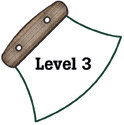
Alaska Science
Key Element C8
A student who meets the content standard should understand that acceptance of a new idea depends upon supporting evidence and that new ideas that conflict with beliefs or common sense are often resisted.
 |
Alaska Science A student who meets the content standard should understand that acceptance of a new idea depends upon supporting evidence and that new ideas that conflict with beliefs or common sense are often resisted. |
|
Performance Standard Level 3, Ages 11–14
|
|
|
|
Sample Assessment Ideas
|
Standards Cross-References
|
||
|
National Science Education Standards Scientific explanations emphasize evidence, have logically consistent arguments, and use scientific principles, models, and theories. The scientific community accepts and uses such explanations until displaced by better scientific ones. When such displacement occurs, science advances. (Page 148) Scientists formulate and test their explanations of nature using observation, experiments, and theoretical and mathematical models. Although all scientific ideas are tentative and subject to change and improvement in principle, for most major ideas in science, there is much experimental and observational confirmation. Those ideas are not likely to change greatly in the future. Scientists do and have changed their ideas about nature when they encounter new experimental evidence that does not match their existing explanations. (Page 171) In areas where active research is being pursued and in which there is not a great deal of experimental or observational evidence and understanding, it is normal for scientists to differ with one another about the interpretation of the evidence or theory being considered. Different scientists might publish conflicting experimental results or might draw different conclusions from the same data. Ideally, scientists acknowledge such conflict and work towards finding evidence that will resolve their disagreement. (Page 171) It is part of scientific inquiry to evaluate the results of scientific investigations, experiments, observations, theoretical models, and the explanations proposed by other scientists. Evaluation includes reviewing the experimental procedures, examining the evidence, identifying faulty reasoning, pointing out statements that go beyond the evidence, and suggesting alternative explanations for the same observations. Although scientists might disagree about explanations of phenomena, about interpretation of data, or about the value of rival theories, they do agree that questioning, response to criticism, and open communication are integral to the scientific process. As scientific knowledge evolves, major disagreements are eventually resolved through such interactions between scientists. (Page 171) Tracing the history of science can show how difficult it was for scientific innovators to break through the accepted ideas of their time to reach the conclusions that we currently take for granted. (Page 171) |
Benchmarks Scientific knowledge is subject to modification as new information challenges prevailing theories and as a new theory leads to looking at old observations in a new way. (Page 7) Some scientific knowledge is very old and yet is still applicable today. (Page 7) |
|
Table of Contents | Return to Alaska Native Knowledge Network